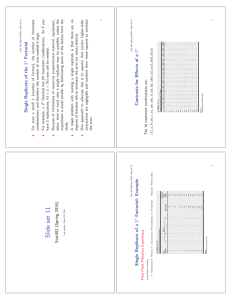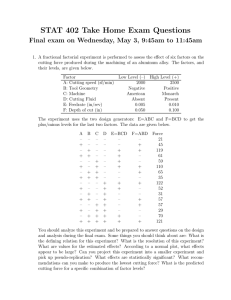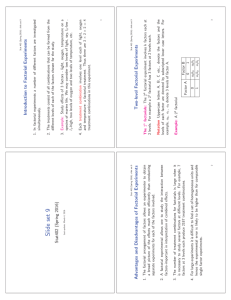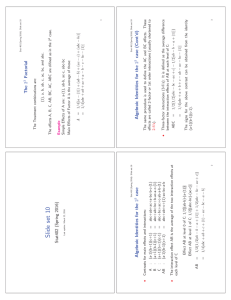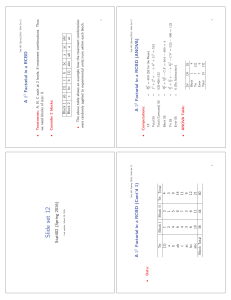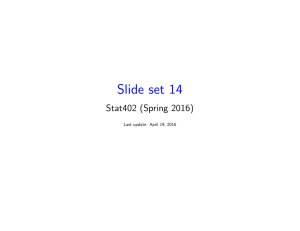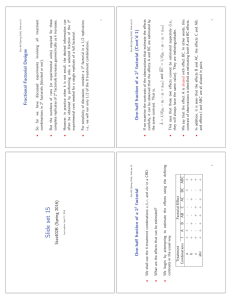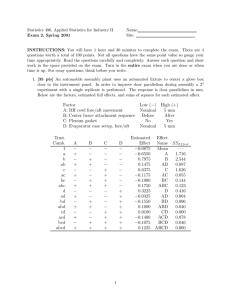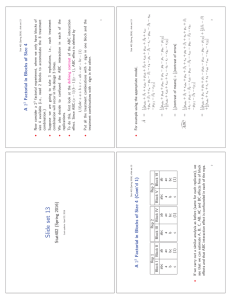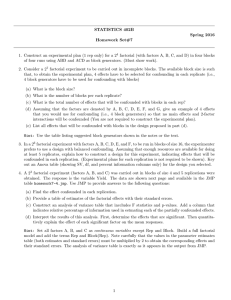rtial a P with
advertisement
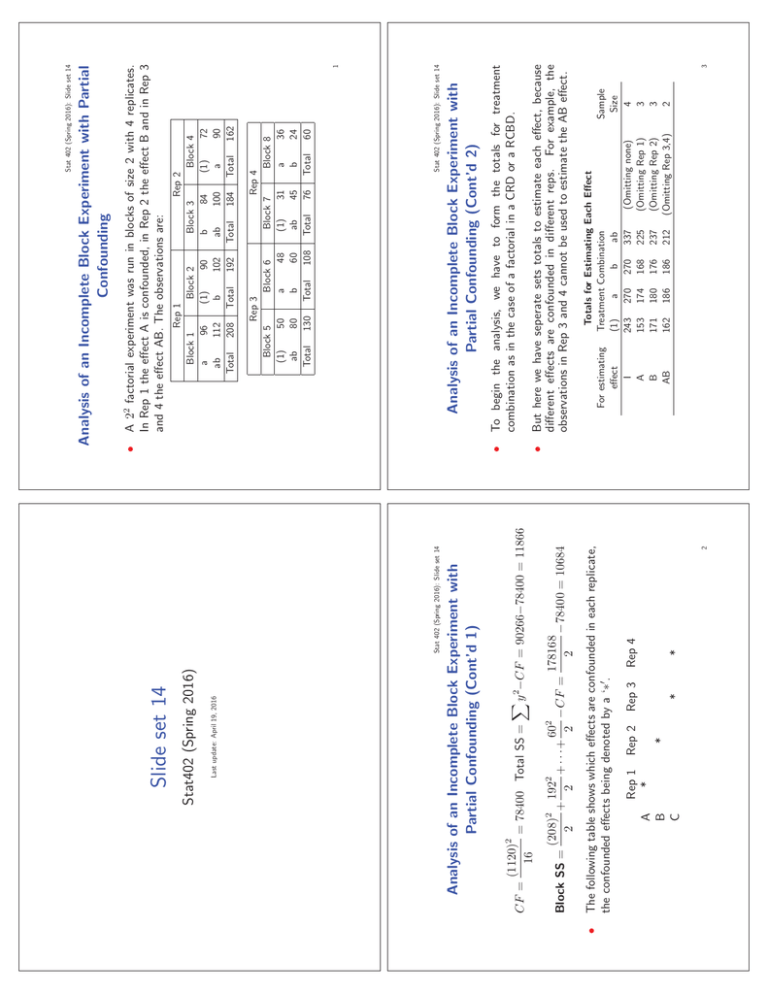
• Stat 402 (Spring 2016): Slide set 14 A B C Rep 1 * * Rep 2 * Rep 3 * Rep 4 2 The following table shows which effects are confounded in each replicate, the confounded effects being denoted by a ‘∗. 602 178168 (208)2 1922 + +· · ·+ −CF = −78400 = 10684 Block SS = 2 2 2 2 (1120)2 CF = = 78400 Total SS = y 2−CF = 90266−78400 = 11866 16 Analysis of an Incomplete Block Experiment with Partial Confounding (Cont’d 1) Last update: April 19, 2016 Stat402 (Spring 2016) Slide set 14 Block (1) ab Total 1 Stat 402 (Spring 2016): Slide set 14 Rep 4 7 Block 8 31 a 36 45 b 24 76 Total 60 Rep 2 Block 3 Block 4 b 84 (1) 72 ab 100 a 90 Total 184 Total 162 Totals for Estimating Each Effect Treatment Combination (1) a b ab 243 270 270 337 (Omitting none) 153 174 168 225 (Omitting Rep 1) 171 180 176 237 (Omitting Rep 2) 162 186 186 212 (Omitting Rep 3,4) Sample Size 4 3 3 2 3 But here we have seperate sets totals to estimate each effect, because different effects are confounded in different reps. For example, the observations in Rep 3 and 4 cannot be used to estimate the AB effect. • For estimating effect I A B AB To begin the analysis, we have to form the totals for treatment combination as in the case of a factorial in a CRD or a RCBD. Analysis of an Incomplete Block Experiment with Partial Confounding (Cont’d 2) Rep 3 Block 5 Block 6 (1) 50 a 48 ab 80 b 60 Total 130 Total 108 Rep 1 Block 1 Block 2 a 96 (1) 90 ab 112 b 102 Total 208 Total 192 A 22 factorial experiment was run in blocks of size 2 with 4 replicates. In Rep 1 the effect A is confounded, in Rep 2 the effect B and in Rep 3 and 4 the effect AB. The observations are: • • Stat 402 (Spring 2016): Slide set 14 Analysis of an Incomplete Block Experiment with Partial Confounding Stat 402 (Spring 2016): Slide set 14 p Block 2 b ac Block 3 c ab Block 4 (1) abc c) Which of the effects are confounded in the experiment? Block 1 a bc 6 7 which implies, as before, that A is not confounded with blocks and thus can be estimated. If this procedure is repeated for all other effects, we would find that AB, AC and BC, i.e., 3 effects in all, are confounded. Â = 1/4[yabc,4 + yab,3 + yac,2 + ya,1 − ybc,1 − yb,2 − yc,3 − y(1),4] = 1/4[μabc + μab + μac + μa − μbc − μb − μc − μ(1)] +(β4 + β3 + β2 + β1 − β1 − β2 − β3 − β4) +(contrast of error terms) = A + (contrast of error terms) we find that A = 1/4[abc + ab + ac + a − bc − b − c − (1)] As before we can write out each of the effects using the appropriate model and determine what effects are confounded. For example, using Stat 402 (Spring 2016): Slide set 14 1. A 23 factorial in 2 blocks i.e., the block size used was 4. This is again an example of a 2k factorial in 2p blocks. Here k=3 and p=1. 2. A 22 factorial in 2 blocks i.e., the block size used was 2. This is an example of a 2k factorial in 2p blocks where k=2 and p=1. 3. In general, for 2p blocks the block size is 2k−p. F 6.46 10.45 8.91 0.01 Stat 402 (Spring 2016): Slide set 14 a) The treatment combinations, as before, are: (1), a, b, ab, c, ac, bc, abc. b) Suppose that the following design was used: MS 313.2 507.0 432.0 0.5 1526.3 48.5 Stat 402 (Spring 2016): Slide set 14 5 Example 1: 23 Factorial Experiments in 22 Blocks We now consider an example of a 2k experiment in 2p blocks where p takes the value 2. Consider a 23 factorial experiment in 22=4 blocks, i.e., the block size is 2. (k=3, p=2) k SS 939.5 507.0 432.0 0.5 10684.0 242.5 11866.0 So far we have considered the following experiments: Source d.f. Treatments 3 A 1’ B 1’ AB 1’ Blocks 7 Error 5 Total 15 ANOVA Table 4 Factorial Effect I A B AB + + + + + + + + + + 1120 78 72 2 16 6 6 4 70 13 12 0.5 16 12 12 8 78400 507 432 0.5 2 Factorial Experiments in 2 Blocks Treatment Combination (1) a b ab Contrast Divisor for Estimate Estimate Divisor for SS SS Now we can use the defining contrasts for each effect to evaluate the estimates of effects using the corresponding set of totals. Using Contrasts for Estimating Confounded Effects Stat 402 (Spring 2016): Slide set 14 1: 2: 3: 4: Block 1 b c ad abcd g) Thus the design is Block Block Block Block (+, +) (+, −) (−, +) (−, −) Block 4 (1) bc abd acd with with with with Block 3 ab ac d bcd Combinations Combinations Combinations Combinations Block 2 a abc bd cd All All All All a + ad + + b + + bd + - ab + abd - c + + cd + - ac + acd - bc bcd + abc + abcd + + 10 k) AD is called the generalized interaction of ABC anf BCD Thus we see that AD is also confounded. 11 j) In the present example, the third effect confounded is , therefore, given by (ABC)(BCD) = AB 2C 2D = AD i) The third confounded effect is found by the following rule: Pairs of effects that are already confounded are multiplied together algebraically. The odd-powered letters in the algebraic result are retained and the even-powered letters are eliminated to form the other effects that are confounded. h) In this replicate there are 4 blocks, implying that 3 effects should be confounded. Two of these are the ones used as block generators: ABC and BCD. Stat 402 (Spring 2016): Slide set 14 (1) d + Stat 402 (Spring 2016): Slide set 14 Effect ABC BCD Effect ABC BCD d) These will be two of the effects that are going to be confounded. The effects that are chosen for this purpose are called block generators. e) In this example we choose ABC and BCD effects as block generators. Now look at the defining contrasts for these effects: 9 f) The 16 treatment combinations are allocated to the 4 blocks as follows: Example 2 (Cont’d 1) Stat 402 (Spring 2016): Slide set 14 c) However, we select two (since p=2) effects to be used for constructing the design. 8 b) Since the number of blocks is 4, we know that 3 effects will be confounded in this design. a) We have 16 treatment combinations : (1), a, b, ab, c, ac, ..., abcd. Example 2: A 24 factorial in 4 blocks, i.e., 22 blocks of size 4 (k=4, p=2). f) In such a design, we would like to confound effects that are chosen by the experimenter for reasons to be discussed later. The procedure for doing this is illustrated in the following example. e) How do we construct a factorial design where more than one effect is confounded in a replicate? d) The number of effects that are confounded will always be the number of blocks in the replicate minus one. Example 1 (Cont’d 1) Stat 402 (Spring 2016): Slide set 14 Suggested Blocking Arrangements 14 Stat 402 (Spring 2016): Slide set 14 12 Here we see that block effects do not cancel out showing that AD is confounded with blocks. Thus, Â = A + 1/8[−β4 + β2 − β1 + β3 − β1 + β3 − β4 + β2 − β3 +β1 − β2 + β4 − β2 + β4 + −β2 + β4 − β3 + β1] +contrast of error terms = A + contrast of error terms and therefore A is not confounded. Similarly, = AD + 1/8[β4 − β2 + β1 − β3 + β1 − β3 + β4 − β2 AD −β3 + β1 − β2 + β4 − β2 + β4 − β3 + β1] + contrast of errors A = 1/8[−(1) + a − b + ab − c + ac − bc + abc − d + ad − bd + abd − cd + acd − bcd + abcd] ) As before, we may check whether a given effect is confounded or not by using the defining contrast. For example, Example 2 (Cont’d 4) Stat 402 (Spring 2016): Slide set 14 13 The usual approach for constructing a 2k factorial in 2p blocks is to use a table such as Table 7.9) (p.316 of text). Once the block generators are determined, the experimental plan may be constructed using the procedure discussed above. Remarks

